In recent years, the world has witnessed a surge in interest and research surrounding cannabinoids. These compounds, derived from the cannabis plant, have garnered attention for their potential therapeutic benefits. However, before delving deeper into their origins and uses, it’s essential to understand what cannabinoids are.
What Are Cannabinoids?
Cannabinoids are a diverse group of chemical compounds that interact with the body’s endocannabinoid system (ECS). The ECS plays a crucial role in regulating various physiological processes, including pain perception, mood, appetite, and immune response. While there are over 100 known cannabinoids, two primary ones have been extensively studied – THC (tetrahydrocannabinol) and CBD (cannabidiol).
Origins of Cannabinoids:
Cannabinoids have a fascinating history that dates back thousands of years. The cannabis plant, Cannabis sativa, is believed to be one of the oldest cultivated crops. Ancient civilizations recognized its medicinal properties and used it for various purposes, such as pain relief and spiritual rituals. Today, cannabinoids can be obtained from both marijuana and hemp plants.
THC: The Psychoactive Compound
THC is perhaps the most well-known cannabinoid due to its psychoactive effects. It is responsible for the “high” associated with marijuana use. THC activates specific cannabinoid receptors in the brain, resulting in altered perception, mood changes, and relaxation. While recreational use of THC is prevalent, it also has potential medical applications for conditions like chronic pain and nausea.
CBD: The Non-Psychoactive Wonder
CBD has gained significant attention in recent years due to its potential therapeutic benefits without the psychoactive effects of THC. It interacts with various receptors in the body to promote balance and homeostasis. Studies suggest that CBD may have anti-inflammatory, analgesic, and anxiolytic properties, making it a promising option for conditions such as anxiety, epilepsy, and chronic pain.
Medical Uses of Cannabinoids:
The medical use of cannabinoids has shown promise in diverse areas. Here are a few notable applications:
1. Pain Management: Both THC and CBD have demonstrated analgesic properties, providing relief for individuals suffering from chronic pain conditions like arthritis, multiple sclerosis, and fibromyalgia.
2. Mental Health: CBD has gained recognition for its potential benefits in managing anxiety, depression, and even post-traumatic stress disorder
3. Multiple sclerosis (MS): Cannabinoids have shown potential in reducing muscle spasms and stiffness associated with MS, improving mobility and quality of life for patients.
4. Nausea and vomiting: Cannabinoids, particularly THC, can help alleviate nausea and vomiting in patients undergoing chemotherapy or those with conditions such as HIV/AIDS.
5. Epilepsy: Some cannabinoids, such as CBD, have shown promise in reducing the frequency and severity of seizures in certain types of epilepsy.
6. Glaucoma: Studies suggest that cannabinoids can help lower intraocular pressure, a major risk factor for glaucoma, potentially preserving eyesight.
7. Appetite stimulation: Certain cannabinoids can increase appetite, which is particularly useful for patients suffering from decreased appetite due to cancer or HIV/AIDS.
8. Sleep disorders: Cannabinoids have been reported to improve sleep quality and help manage insomnia by promoting relaxation and reducing anxiety.
9. Inflammatory bowel diseases (IBD): Some studies have suggested that cannabinoids can help reduce inflammation and relieve symptoms like abdominal pain and diarrhea in patients with IBD.
10. Neurodegenerative diseases: There is growing evidence that cannabinoids may have neuroprotective properties, potentially benefiting patients with conditions such as Alzheimer’s, Parkinson’s, and Huntington’s disease.




Cras id vehicula est, tincidunt pellentesque magna. Etiam porttitor nulla urna, quis vulputate justo euismod ac. Nunc viverra sollicitudin fringilla.
Etiam placerat velit vitae dui blandit sollicitudin. Vestibulum tincidunt sed dolor sit amet volutpat. Nullam egestas sem at mollis sodales. Nunc eget lacinia eros, ut tincidunt nunc. Quisque volutpat, enim id volutpat interdum.